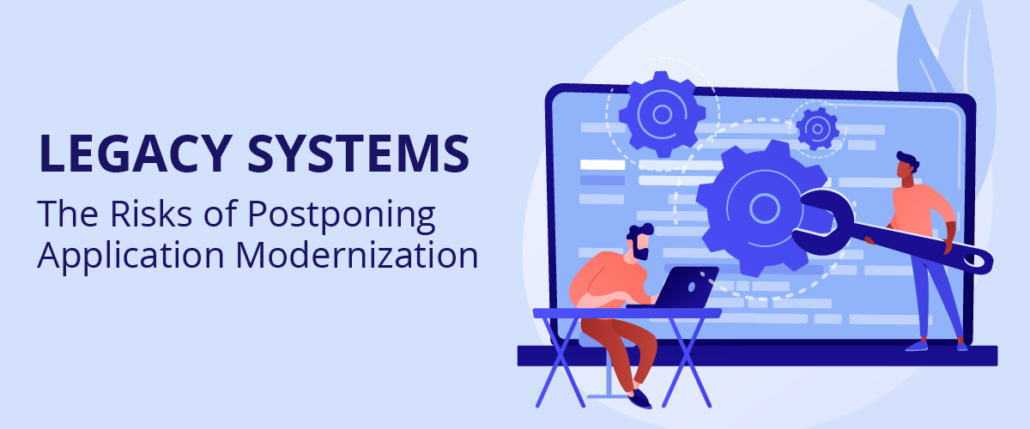Legacy Systems: The Risks of Postponing Application Modernization
Legacy systems are systems near the end of their life cycle. While still functional, legacy systems are potentially detrimental from both a technical and business point of view. This can cause problems from internal communication issues to setbacks going to market. If ignored, legacy systems can even drive companies out of business.
However, knowing these issues with aging systems hasn’t stopped organizations from keeping them running. Modernization is indeed an arduous process, often dismissed as systems remain operative. Therefore, companies must acknowledge that modernizing not only improves their processes and increases profit but modernizing their legacy applications will also help them preserve the well-being of their business and stay competitive.
In this article, we will tackle what organizations can lose when postponing modernizing a legacy system. We’ll also provide a short review of the available solutions for modernization, including cloud technologies.
Why should companies modernize?
Coming back to the system evolution scale, software modernization is a step after software updating and at the doorstep of system replacement. Modernizing a system is a more cost-effective choice than replacing it altogether. Moreover, organizations may be too reliant on these applications —despite their issues— to retire them.
However, legacy systems can harm organizations in many ways. The following is a list of problems legacy systems may bring. Take a moment to acknowledge if these problems exist in your organization’s systems:
- Losing clients due to poor, outdated, or non-functioning product UI/UX.
- Keeping business operations becomes too costly in comparison with competitors who rely on newer systems
- System maintenance monopolizes the IT budget
- Security issues that cannot be fixed
- Applications are built on outdated languages restricting integration with new technologies and processes such as inventory for payments.
As we can imagine, not addressing these issues can be extremely detrimental, Even in ways that were initially unthinkable.
Richard Reukema is a software solutions architect at Optimus Information with decades of experience in the IT field. According to him, relying on outdated technologies has the potential for hurting business so massively that you simply can’t ignore it. Richard quotes the cases of Uber and Airbnb as examples of this behaviour: “How many CEOs of the taxi industry and hotel industry saw a dynamic scale application eating 40% of their market? Zero”. Richard understands that these companies based their success on improving customer experience with new technologies: “The level of information that is available to the customer and the convenience of the transaction and the customer experience is vastly different because the old companies just couldn’t imagine a new process in which we use technology to simplify the experience of the customer”.
How to start application modernization
Application modernization starts in the planning stage. To modernize, it is necessary first to learn about the full landscape in which the application runs. In other words, learning about what applications it interacts with and how it does so. This isn’t an easy task: Usually, the landscape of these applications is as cryptic as the applications themselves. In his Master on Computer Science academician Simon Nilsson understands that there are two approaches for starting the modernization process:
- White-box modernization or software reengineering: reverse-engineering the application to learn about its components and ecosystem and how it works.
- Black-box modernization: looking at how the application interacts in its operating context (inputs and outputs) to learn about it.
Once the application becomes known, it is possible to choose a fitting solution. Simon divides modernization solutions into four categories:
- Automated migration: using tools such as parsers to migrate languages, databases, and platforms.
- Re-hosting: hosting the legacy system on a different platform.
- Package implementation: using off-the-shelf software.
- SOA Integration: taking the legacy application’s business logic and data embedded and turning them into services.
When figuring out the most appropriate solution for modernization, more often than not, the available budget ends up being as important as meeting the very specific requirements of the system. Yet there are solutions that can fit some cases and are not as overly expensive as others. For instance, low-code development platforms are a plausible and economic solution for modernization. Consulted about this technology, Richard Reukema finds room for low-code development platforms in modernization, yet he defines them as double-edged swords. Richard understands that low-code environments increase the complexity of the organization by being inaccessible to the different departments in which they operate. In his words, “low code environments in corporate settings are extremely difficult to manage because managers have credit cards and (therefore) they have to compute thousands of operations”.
Solutions for modernizing legacy systems
The following is a brief overview of different solutions for application modernization.
Azure Platform as a Service (PaaS)
PaaS is a complete cloud solution that includes everything from infrastructure and middleware to development tools and database management systems. The idea behind PaaS is to cover the full application cycle, including building, testing, and deploying.
Thanks to PaaS, organizations don’t have to manage a multitude of software licenses, and instead, rely on a unified set of applications and services managed by the PaaS provider.
Containerization
Containers are software code packages made of the bare minimum software for running the application proficiently in any infrastructure. Containers are isolated from the rest of the system, making them a great solution for dealing with incompatibilities, a common problem found in legacy systems. When at scale, containers are managed and automated by other programs, Kubernetes being one of the most popular.
Microservices
Containers have made it possible to build scalable architectures out of numerous services. By disassembling software, more efficient use and maintenance of it is possible. This can make us think that microservices are the solution for modernizing every legacy monolithic application. However, microservice architecture is far from perfect. According to Richard, the problem with microservices is scalability. “I’ve seen microservices used to the point where they’re so granular, that there are so many microservices, that there are so many REST calls, the whole system just can operate at scale”, he says.
We have seen how critical modernizing legacy applications is, how it starts, and what solutions are available. The next step is to find the right technology and implementation for your case. Get in touch with Optimus to learn more about solutions for your organization.




